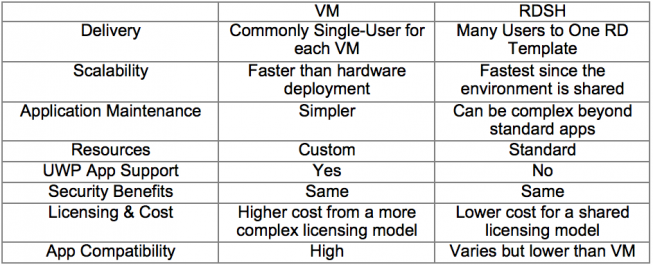There is little doubt that in today’s demanding computing environments, where budgets are tighter and expectations for technological returns of investment high, organizations can meet their needs in a variety of hosted solutions. When it comes to desktop computing business users, hardware and necessary support can be some of the main drivers behind costs. But with the expectations to achieve more with applications, there are solid alternatives to desktop computers.
Virtualized computing offers quite a lot of useful solutions for business class customers. Options such as VMs and Remote Desktop Session Host offer varying degrees of organizational efficiency with OS flexibility, scalability, savings, overhead reduction, and consistent security.
These two options for business users provide many of the same features but have their own advantages and drawbacks versus each other. With either, expectations can be met while achieving cost reduction.
Virtual Machine Based Deployment: The Custom Experience
Since VMs arrived on the computing scene, they quickly challenged the Remote Desktop Session Host solutions such as Citrix (one of the longest used options for shared desktop solutions) and that offered by Windows (originally known as Terminal Services). Virtual machines, as the name implies, work the same as an actual physical desktop computer. These virtual machines are files which are created on storage appliances and servers which users can log onto from a terminal. VM users are presented with a one to one (VM to user) computing solution.
Virtual machines also come with virtual devices and drivers which allow them to run off of resources provided through storage. The experience for users is much the same and allows for the use of a wide range of applications. Resources for the virtual machines do not change since these are already defined just like a physical desktop computer would have specifically installed storage, memory and CPU. Users can easily access and work on virtual machines just as if there were a physical computer on the desk. It is a custom experience that meets specific needs.
Remote Desktop Session Based Deployment: The Standard Environment
Remote Desktop Session Host (also known as session-based virtualization) has been around quite a bit longer than virtual desktops with varying platforms from Citrix to the Windows Remote Desktop. RDSH is different from virtual machines in that they are not presented to the user in the same way as a virtual machine would run. A virtual machine is essentially a PC hosted on remote storage. However, a remote desktop is a standard, shared user experience which does not vary and runs only those applications which are presented to the user through a limited desktop interface, usually through policy. This is a one-to-many solution where one standard desktop is presented to many users.
While a physical terminal is used in both instances, a remote desktop does not use any virtual devices such as memory, storage and CPU. The user experience is very much standard and has much of the same feel as working on a virtual machine or personal computer. The difference is that remote desktops are only active when a user logs in to their desktop via a server running the shared desktop environment such as Citrix or RDSH.
While both types of hosted computing allow for users to save files and share data, the cost and overhead can be quite different. This is because the differences between the two solutions are fundamentally different at their base in that virtual machines are much more of a customized experience versus RDSH commonly being a highly standardized experience.
Advantages of VMs
Virtual machines have their own set of advantages versus remote desktop sessions. Since a virtual machine has a defined amount of memory, storage and CPU, there is no chance that a user process will disrupt other users since the experience is not one shared at the machine level. Resources for virtual machines are made available via storage and software management.
Additionally, virtual machines offer organizations the ability to use a wider range of applications. Also, applications do not have to be installed on every virtual machine. Since some classes of users may require applications which use more resources, virtual machines can be customized to fit the demands of applications, especially those that use high-end graphic design and modeling.
Virtual machines specifically offer the same experience as that of a PC without the overhead of hardware maintenance. This kind of hosted computing provides all the power necessary at a lower cost, allowing for highly customizable VM’s which are presented to users.
Remote Desktop Session Host (RDSH) Advantages
RDSH solutions easily mimic those of virtual machines but with a key difference; while virtual machines can be customized based on need, remote desktops are often standardized so that users have a limited number of applications which they can use. While the standardization creates limits, it is also less expensive than VMs. Common computing needs are easily delivered to a larger number of users through a terminal experience which is easily scaled at lower cost.
The Drawbacks of Each Solution
There are clear advantages with each of these remote computing solutions. However, VM’s and Remote Desktop’s each have their drawbacks. VM’s require a higher budget due to licensing for operating systems, something which is far cheaper with RDSH because the operating system is shared to many users. VMs also put a higher demand on storage systems for customized solutions. Remote desktops do not have the same demands for resources since these are shared. With remote desktops, only those resources required by logged-on users are active.
However, Remote Desktop’s can create bottlenecks from processes which take up too many resources. Likewise, nonstandard applications may not easily be presented to Remote Desktop sessions. Additionally, other application maintenance and installation may be more difficult with RDSH while applications with higher demand for resources can make hosting these applications challenging.
Since Windows server 2016 is the main hosting platform for remote desktop, much of the current advantages from Windows 10 are not available, the latter offering the Universal Windows Platform (UWP). UWP is the basis for the Windows Store in Windows 10 and any applications which are developed for this platform will not function, or may not have the same functionality, via RDSH on Windows server 2016. Whereas Windows 10 VMs will be able to use any UWP-based applications.
Choosing Between the Two
Both of these models for remote computing are highly desirable and useful, but for different reasons. They each offer their own advantages and flexibility. The server based Remote Desktop is far more scalable since not all resources for each user are required all of the time because not all users may be logged on at the same time and can be presented by policy.
Meanwhile, virtual machines offer a highly customizable environment for demanding user needs. Memory storage and amount of CPU can be customized to fit applications. VMs offer a wider range of applications versus the more standardized offerings for RDSH. There is also less application maintenance required for virtual machines.
The determining factors when choosing between RDSH and VM’s are dependent on cost and need. A large organization may only need to offer remote desktop to a high number of employees with standard computing requirements, so this solution can be very cost-effective. Meanwhile, a smaller organization may need virtual machines for a larger percentage of high-end users because of more specialized applications and their requirements. Often times, organizations may find that they need a mixture, or hybrid solution, between these two types of remote computing.
Neither solution is specifically better than the other, it is more of a degree of fit for needs and budget. Each solution provides very consistent security. It is the variations between licensing, application compatibility, and other factors which will determine the decision between these two options or using them together.
Consider these details when choosing remote computing solutions:

To learn more about Virtual Machines, RDSH or other Azure cloud services, contact our experts at RoyalDiscount.com– Your online source for cheap OEM, Retail & Cloud products.

